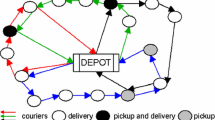Abstract
In this paper, the preference-based methods are proposed to solve the multi-objective optimization of the capacitated vehicle routing problem (CVRP) considering transportation time on different types of road. The objective functions are to minimize the transportation distance and time subject to capacity constraint when the transportation time depends on types of road. We perform the multi-objective optimization for CVRP in three steps. In the first step, the customer nodes are clustered according to the geographical coordinates of the nodes. Therefore, each cluster can be handled separately and in parallel by using cloud computing which is effectively applied in various applications for a large data analysis. In the second step, non-dominated sorting genetic algorithm-II which is a well-known searching algorithm is applied to find the optimal routing paths from the depot to customers in each cluster. Finally, the preference-based method is considered to identify the appropriate solutions among the trade-off solutions (the non-dominated solutions) according to the decision maker’s preferences. This method expresses the decision maker’s preference as the reference values or ranking of the objective functions. The algorithm is demonstrated with a well-known instance of the CVRP.


Similar content being viewed by others
References
Christofides, N., Mingozzi, A., Toth, P.: The vehicle routing problem. In: Sandi, C. (ed.) Combinatorial Optimization, pp. 315–338. Wiley, Chichester (1979)
Dantzig, G.B., Ramser, J.H.: The truck dispatching problem. Manag. Sci. 6(1), 80–91 (1959). Retrieved on 2008-04-17
Deb, K.: Multi-Objective Optimization Using Evolutionary Algorithms, pp. 13–14. Wiley, New York (2008)
Deb, K., Pratab, A., Agrawal, S., Meyarivan, T.: A fast and elitist nondominated sorting genetic algorithm for multi-objective optimization: NSGA II. IEEE Trans. Evol. Comput. 6, 182–197 (2002)
Deb, K., Sundar, J., Udaya Bhaskara Rao, N., Chaudhuri, S.: Reference point based multi-objective optimization using evolutionary algorithms. Int. J. Comput. Intell. Res. 2(3), 273–286 (2006)
Dechampai, D., Tanwanichkul, L., Sethanan, K., Pitakaso, R.: A differential evolution algorithm for the capacitated VRP with flexibility of mixing pickup and delivery services and the maximum duration of a route in poultry industry. J. Intell. Manuf. 2015, 1–20 (2015)
Durillo, J.J., Nebro, A.J.: jMetal: a java framework for multiobjective optimization. Adv. Eng. Softw. 42, 760–771 (2011)
Durillo, J.J., Prodan, R.: Multi-objective workflow scheduling in Amazon EC2. Clust. Comput. 17(2), 169–189 (2014)
Fisher, M.L.: Jaikumar, Ramchandran.: generalized assignment heuristic for vehicle routing. Networks 11(2), 109–124 (1981)
Flaberg, T., Hasle, G., Kloster, O., Riise, A.: Towards Solving Hugescale Vehicle Routing Problems for Household Type Applications. Network Optimization Workshop, Saint-Remy de Provence (2006)
He, R., Xu, W., Sun, J., Zu., B.: Balanced k-means algorithm for partitioning areas in large-scale vehicle routing problem. In: Proceedings of 3rd International Symposium on Intelligent Information Technology Application, vol. 3, pp. 87–90. Nanchang (2009)
Homberger, J., Gehring, H.: A two-phase hybrid metaheuristic for the vehicle routing problem with time windows. Eur. J. Oper. Res. 162, 220–238 (2005)
Kessaci, Y., Melab, N., Talbi, E.-G.: A Pareto-based metaheuristic for scheduling HPC applications on a geographically distributed cloud federation. Clust. Comput. 16(3), 451–468 (2013)
Ostertag, A., Doerner, K.F., Hartl, R.F., Taillard, E.D., Waelti, P.: POPMUSIC for a real-world large-scale vehicle routing problem with time windows. J. Oper. Res. Soc. 60(7), 934–943 (2009)
Ramirez, A.J., Knoester, D.B., Cheng, B.H.C., McKinley, P.K.: Plato: a genetic algorithm approach to run-time reconfiguration in autonomic computing systems. Clust. Comput. 14(3), 229–244 (2011)
Reed, M., Yiannakou, A., Evering, R.: An ant colony algorithm for the multi-compartment vehicle routing problem. Appl. Soft Comput. J. 15, 169–176 (2014)
Ruiz, P., Dorronsoro, B., Bouvry, P.: Finding scalable configurations for AEDB broadcasting protocol using multi-objective evolutionary algorithms. Clust. Comput. 16(3), 527–544 (2013)
Solomon, M.M.: Algorithms for the vehicle routing and scheduling problem with time window constraints. Oper. Res. 35, 254–265 (1987)
Sooktip, T., Wattanapongsakorn, N.: Pruning algorithm for multi-objective optimization with decision maker’s preferences of system redundancy allocation problem. In: 2014 International Conference on IT Convergence and Security, ICITCS 2014, art. no. 7021801 (2014)
Wang, J., Zhou, Y., Wang, Y., Zhang, J., Chen, C.L.P., Zheng, Z.: Multiobjective vehicle routing problems with simultaneous delivery and pickup and time windows: formulation, instances, and algorithms. IEEE Trans. Cybern. Article in Press (2015)
Zitzler, E.: Evolutionary Algorithms for Multiobjective Optimization: Methods and Applications. Shaker, Ithaca (1999)
Acknowledgments
Financial support from Thailand Research Fund through the Royal Golden Jubilee Ph.D. Program, National Research University Project of Thailand and King Mongkut’s University of Technology Thonburi are acknowledged.
Author information
Authors and Affiliations
Corresponding author
Appendix
Appendix
Assumption:
-
(1)
Local road has speed limit 30 km/h: L
-
(2)
City road has speed limit 60 km/h: C
-
(3)
Expressway has speed limit 90 km/h: E
Rights and permissions
About this article
Cite this article
Sooktip, T., Wattanapongsakorn, N. Identifying preferred solutions for multi-objective optimization: application to capacitated vehicle routing problem. Cluster Comput 18, 1435–1448 (2015). https://doi.org/10.1007/s10586-015-0478-0
Received:
Revised:
Accepted:
Published:
Issue Date:
DOI: https://doi.org/10.1007/s10586-015-0478-0




